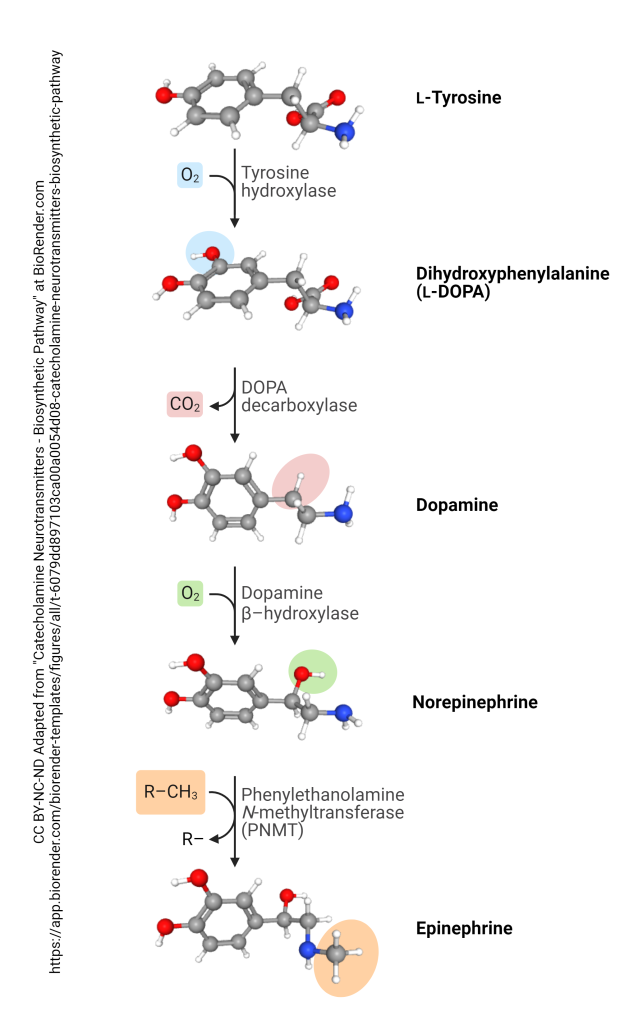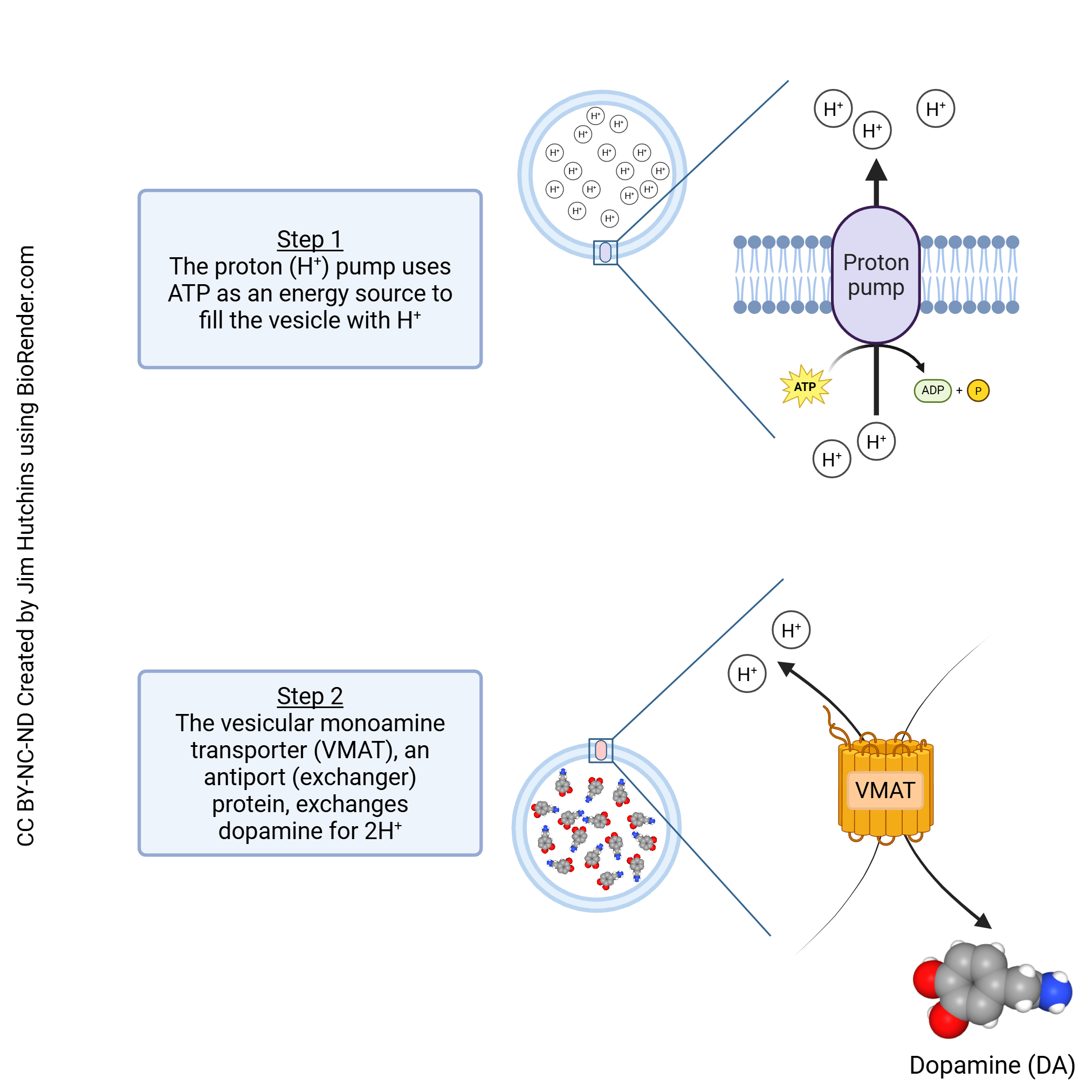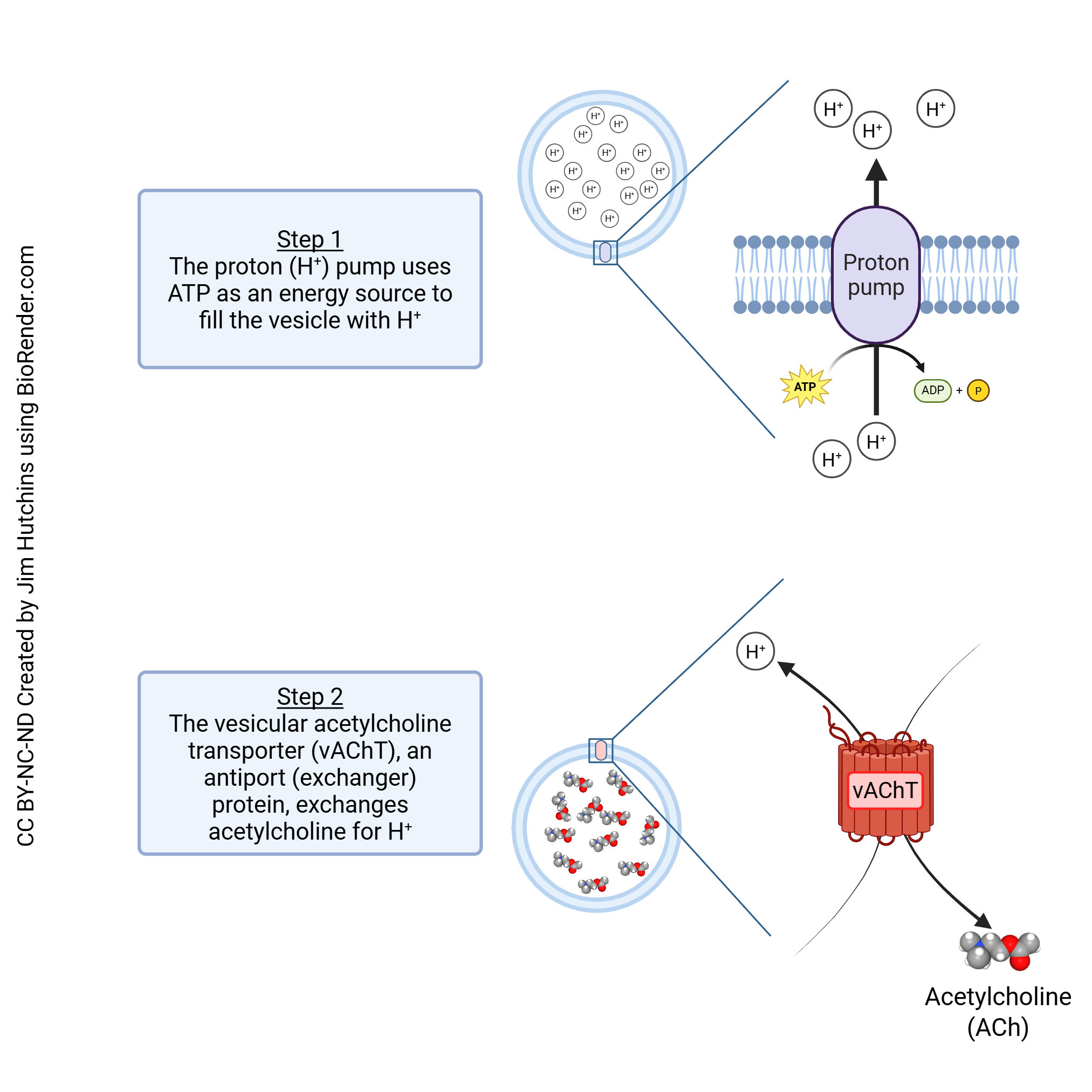Packaging Neurotransmitter Into Vesicles
Caleb Bevan
Objective 2: Name the steps in the packaging of neurotransmitters into vesicles.
The first known neurotransmitters were discovered in the first half of the 20th century. These have a molecular weight in the 100 Da to 350 Da range. For this reason, they are called small-molecule neurotransmitters. Acetylcholine, dopamine, norepinephrine[1], epinephrine[2], serotonin, glycine, and glutamate fit into this category. These neurotransmitters are made by enzymes found in the cytoplasm.

For example, acetylcholine is made from negatively-charged acetate ions and positively-charged choline ions by an enzyme called choline acetyltransferase.

Dopamine, norepinephrine, and epinephrine are made in a chained series of reactions: the amino acid tyrosine is converted to L-DOPA by tyrosine hydroxylase. L-DOPA is then converted to dopamine, which can be converted to norepinephrine, which can be converted to epinephrine.
The rate-limiting step is the step in this process which regulates the speed of the entire series of reactions. Imagine an assembly line where the guy putting the fenders on is the slowest; no cars could be made faster than Clyde puts the fenders on. Clyde is the rate-limiting step. The rate-limiting step in dopamine synthesis is catalyzed by tyrosine hydroxylase. The loss of tyrosine hydroxylase in specific brainstem neurons is an important mechanism in Parkinson disease.
The amino acid neurotransmitters are brought into the neuron as a non-receptor-binding amino acid and then converted inside the presynaptic terminal to the active amino acid. For example, the amino acid glutamine is passed between cells, but once it arrives in the presynaptic terminal it is converted to glutamate.
Once the neurotransmitter is made, in most cases, it is packaged into membrane-bound vesicles. This process is carried out by proteins called vesicular transporters, which are listed in the box below.
Examples of Vesicular Transporters

 Most hydrogen atoms consist of a single proton and a single electron. If the electron is removed, we are left with a proton, also called a hydrogen ion (H+). [4] When a solution contains more protons than pure water, we call it an acid; for example, the hydrogen ion concentration of stomach acid is about 100,000 times higher than the cytoplasm of the cells that make up the stomach.
Most hydrogen atoms consist of a single proton and a single electron. If the electron is removed, we are left with a proton, also called a hydrogen ion (H+). [4] When a solution contains more protons than pure water, we call it an acid; for example, the hydrogen ion concentration of stomach acid is about 100,000 times higher than the cytoplasm of the cells that make up the stomach.
The first step in packaging neurotransmitter into vesicles is to use a proton pump to move protons into the vesicle. Now the vesicle has a pH of about 5, meaning that it is about 250X more acidic than the cytoplasm of the presynaptic neuron. [5]
Why do we have to use energy (ATP) to actively pump protons into the vesicles? Because in the next step, the vesicular transporter protein exchanges those protons for the neurotransmitter, moving it from the cytoplasm where it is at lower concentration into the vesicle where there are already plenty of neurotransmitter molecules and therefore the concentration of neurotransmitter is higher. Thus vesicular transporters are one example of antiporters, also called exchangers. You might remember that this system is called secondary active transport because it requires energy, but the energy is used in a step removed from the actual movement of the neurotransmitter molecule.
Media Attributions
- Synthesis of acetylcholine © Jim Hutchins is licensed under a CC BY-NC-ND (Attribution NonCommercial NoDerivatives) license
- Synthesis of catecholamine neurotransmitters v2 © BioRender adapted by Jim Hutchins is licensed under a CC BY-NC-ND (Attribution NonCommercial NoDerivatives) license
- Vesicular Monoamine Transporter © Jim Hutchins is licensed under a CC BY-NC-ND (Attribution NonCommercial NoDerivatives) license
- Vesicular Acetylcholine Transporter © Jim Hutchins is licensed under a CC BY-NC-ND (Attribution NonCommercial NoDerivatives) license
- also known as noradrenaline ↵
- also known as adrenaline ↵
- the monoamines include: dopamine, norepinephrine, epinephrine, and serotonin ↵
- A liter of pure water contains 10–7 moles of protons (60,221,407,600,000,000 protons). ↵
- These proton pumps are also found in the stomach, where they move protons into the open part (lumen) of the stomach to create stomach acid. ↵

